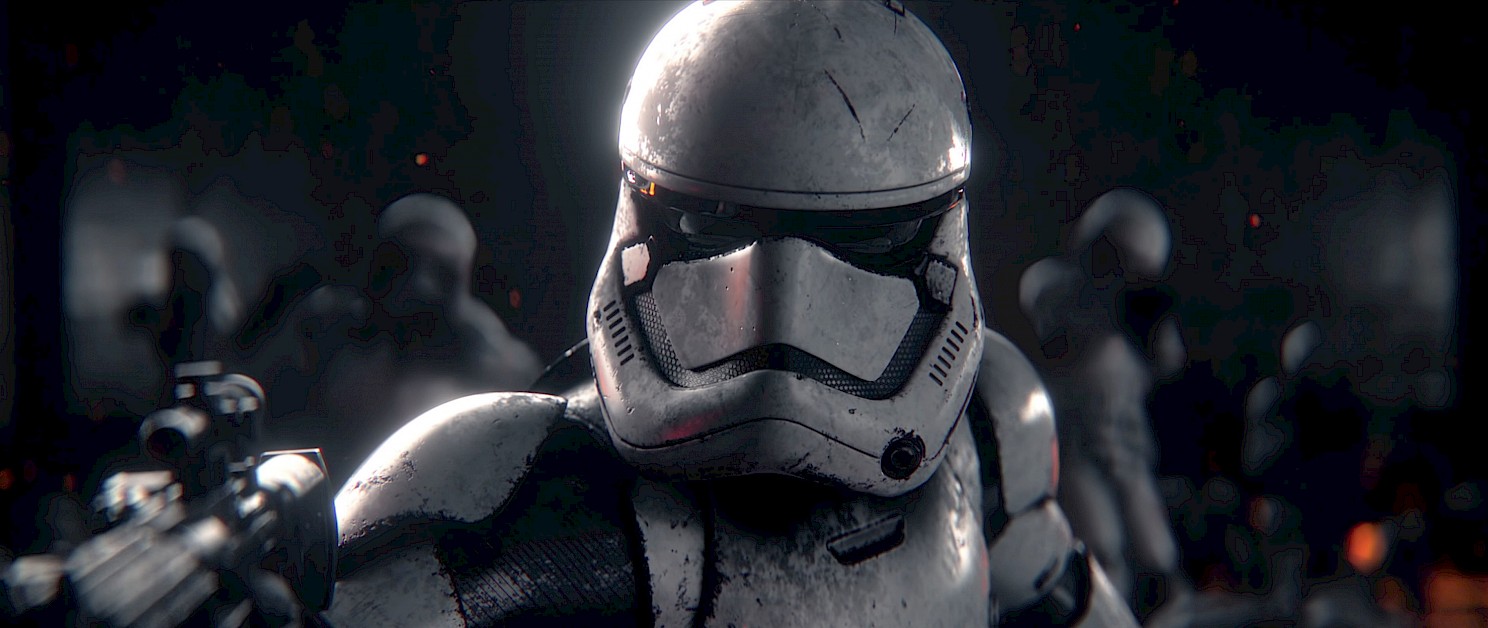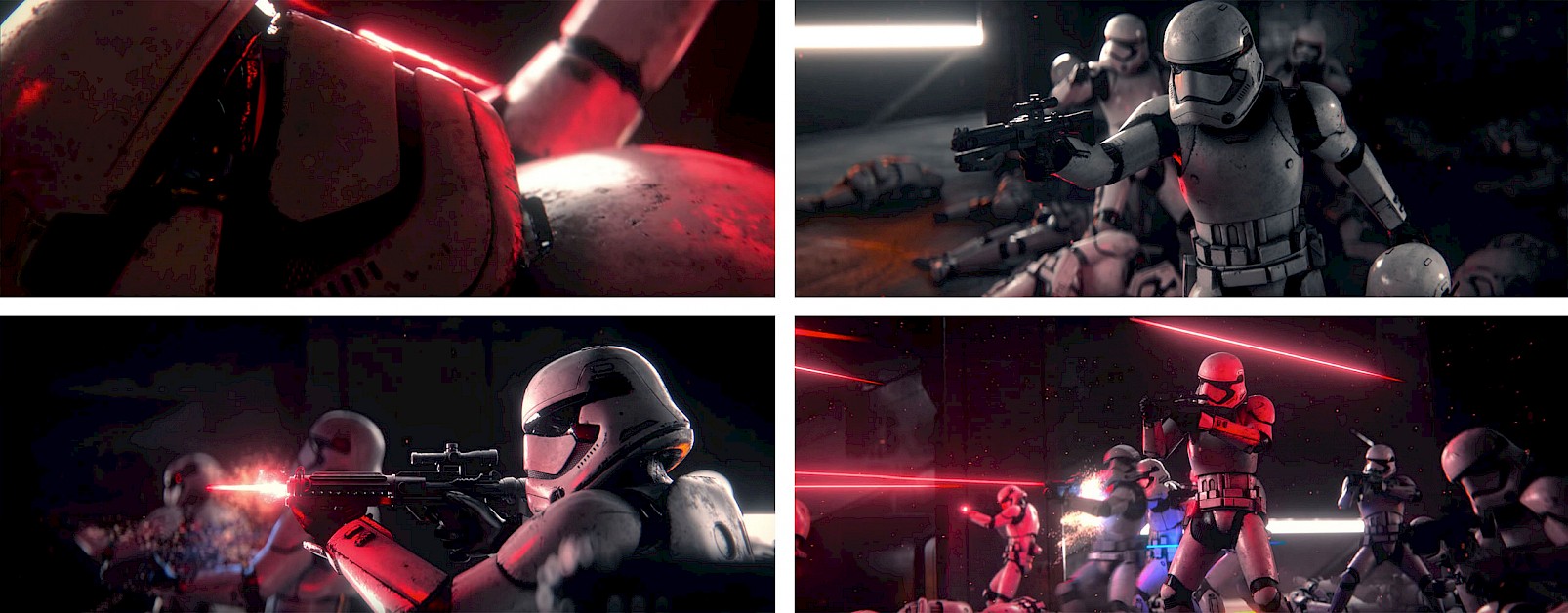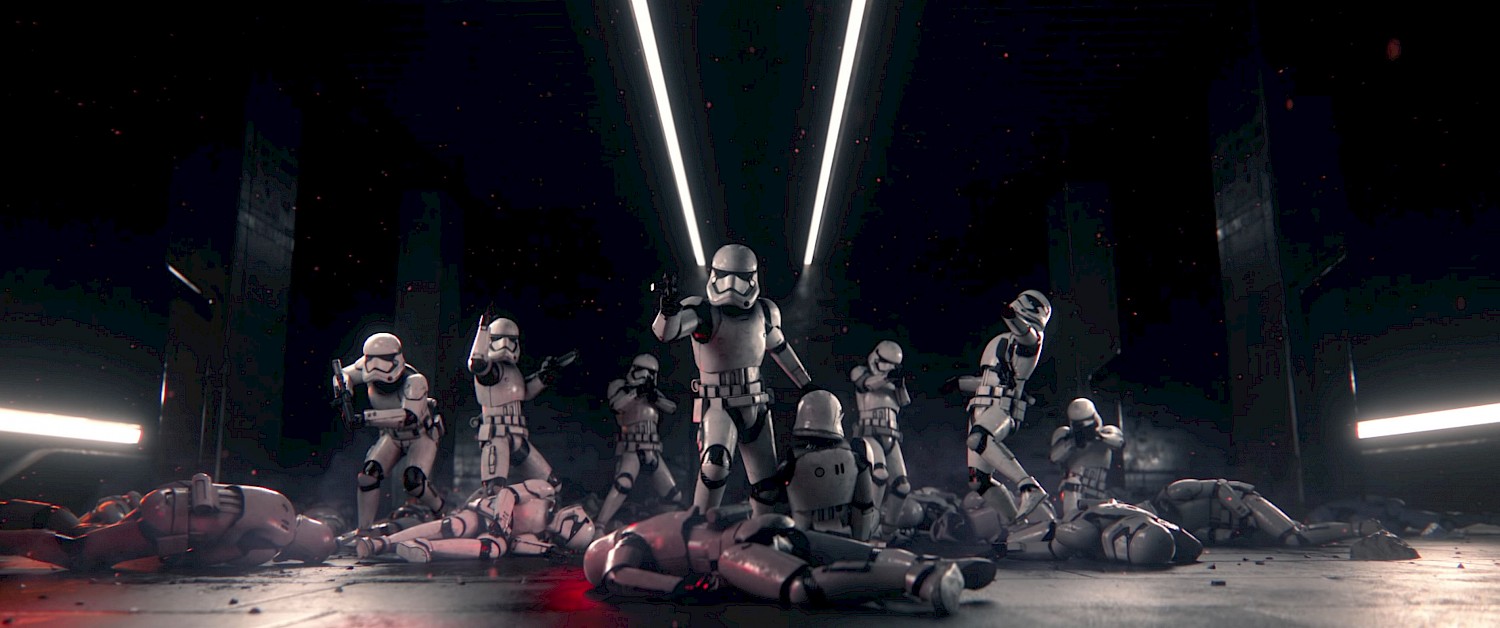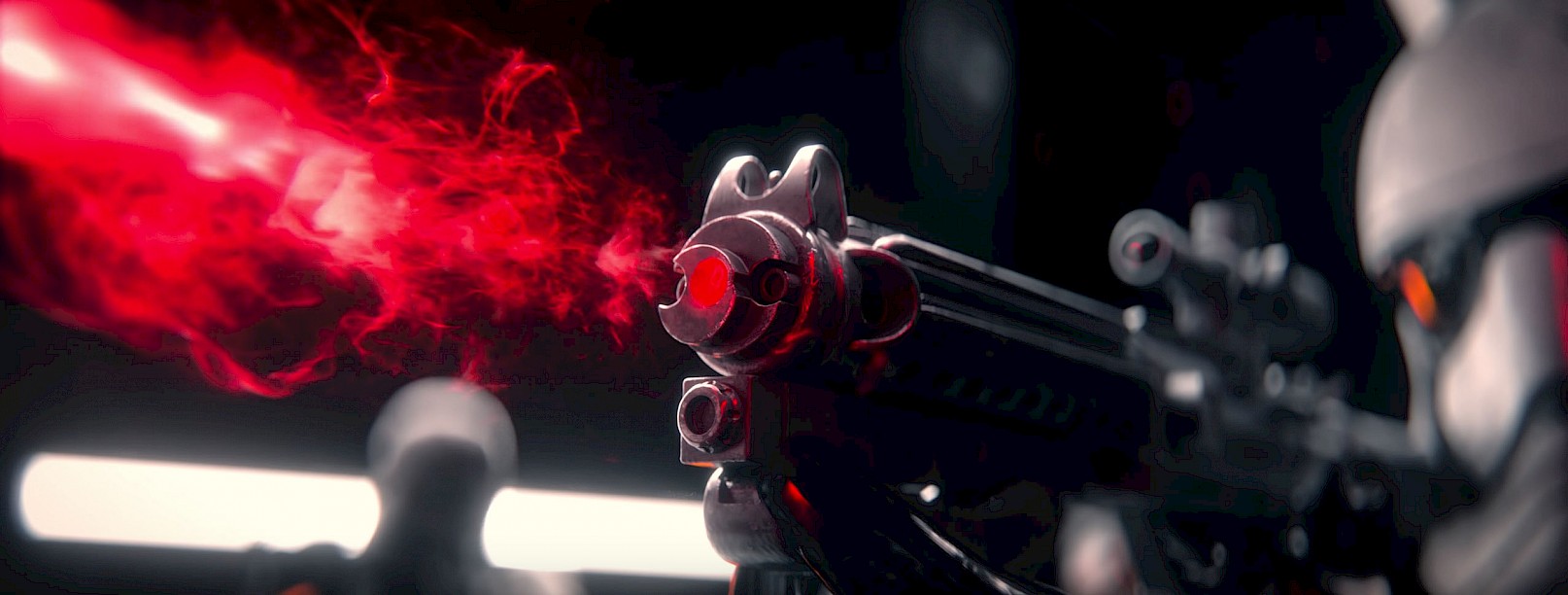Just before Christmas 2019, Sekani Solomon reached out to talk to us about his latest personal project – Star Wars: The Last Stand. Cited by some online media outlets as ‘Better than Rise of Skywalker’! The Last Stand is a short that all Star Wars fans need to watch!
Hi Sekani, thanks for reaching out about your latest project. Can you tell us how you first got the idea of looking at Star Wars from the Stormtroopers’ perspective?
The idea started as a gag. When I worked at Imaginary Forces, I hatched this idea with the IT tech, Aled Jones to put him in a CG world and have him fight Stormtroopers since he loved Star Wars. That didn’t pan out, and the idea kept evolving. I eventually shelved the idea for a few years to finish my short film Hidden before picking the project back up in 2018. I then reimagined the story, focusing it squarely on the Stormtroopers, emphasizing their struggle through the battle.
The piece begins with a close-up FUI shot, looking through the eyes of a Stormtrooper as he sees the world through his visor. He starts to fall to the ground. The camera moves away bringing the fallen 'Trooper into the shot. Dust particles fly upwards as the body hits the floor, what an opener! Can you explain how X-Particles was used in this scene?
That scene was an important one because I knew I had to do something to grab the attention of the viewer quickly. The detail was important here, so naturally, I’d need a lot of particles. What’s great is how easily X-Particles and Redshift communicate with each other. When the 'Trooper hits the floor, it shatters emitting somewhere over a million particles. I then instanced tiny fragments onto those particles using Redshift to give fine detail to the scene. I had three separate particle emitters, one specifically to show particles bouncing off the floor to ground the effect. X-Particles made this process quick and efficient.

It took you three years to bring this project to completion, did this project change shape over time or did you stick to a rigid storyboard throughout?
Throughout those three years, I worked on the project for a few months. It was a start and stop production. When I locked the story in, I pretty much stuck to it to ensure I’d get the production complete.
The scene where we see the inner workings of a Stormtrooper's blaster is another highlight. Your adaptation of the inner workings of the E-11 Blaster Rifle is stunning. Did you have any reference for this area? Or is it simply an artist’s impression?
For this, I took reference from a lightsaber. I thought it would be cool to take some inspiration from a lightsaber and infuse some of its inner workings with a blaster, to make this crazy high powered weapon. I also thought it was important to show that sequence because the film is really about looking at the things we don’t commonly see in the Star Wars Universe. The question I asked was ‘what can I show?’ and ‘how can I show it in a cool way?’.

When you first reached out about your work on this piece, you said that X-Particles featured heavily in pretty much every shot. Can you tell us which shot was your favorite to create and which X-Particles features you used?
One effect I think turned out pretty dope was the huge blue blast that comes in at 46s. Time was running short on production and I knew this was an effect that I had to get done. I decided to give xpExplosiaFX a shot and used that to generate a fire simulation. I used that sim to advect particles to get a more fluid, organic animation. I did two sims using this method and combined them in compositing to great results. The exploding Stormtrooper shots that followed used X-Particles heavily to generate all the tiny particle effects to get all the nuanced details. X-Particles’ easy integration with Mograph and Redshift made it a real joy to use in these shots.
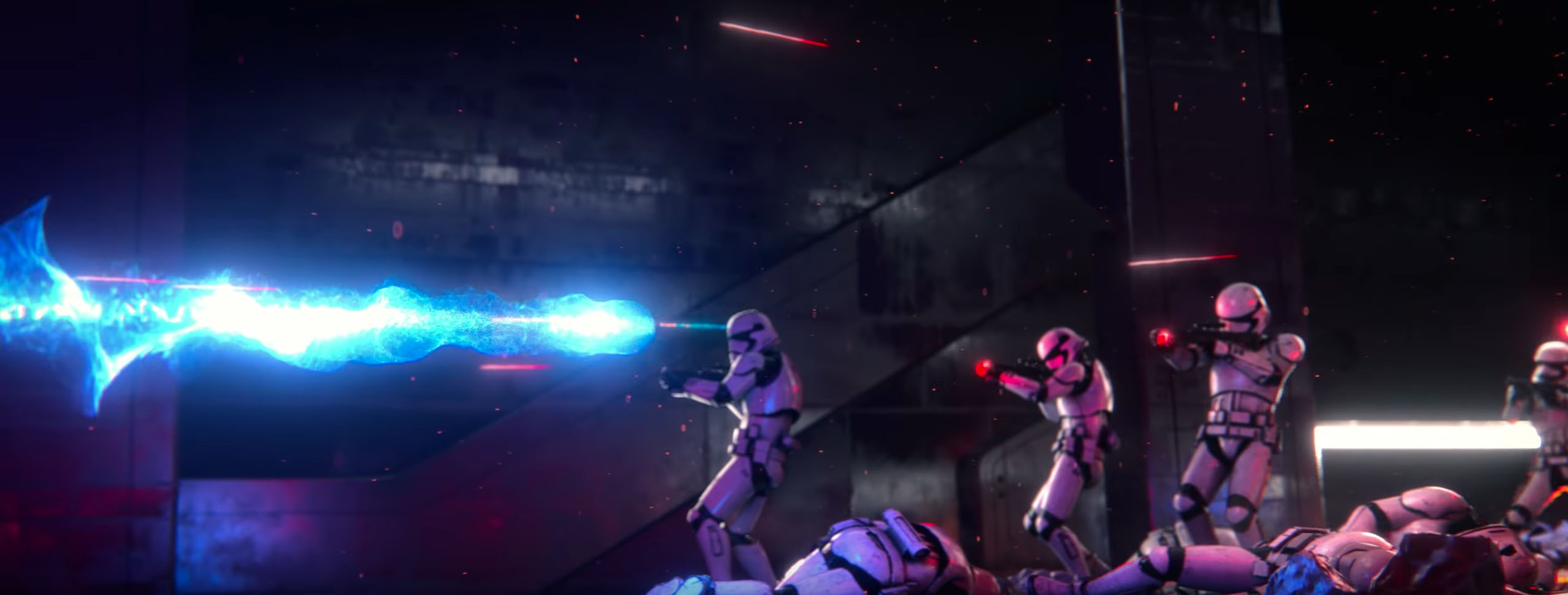
Since we last spoke regarding your last project, Hidden, what has been your favorite X-Particles feature to use?
I don’t necessarily have a favorite feature but more so love how user-friendly X-Particles is. It’s a must for many productions I work on.
The camera angles and slow-motion used throughout really enhances the viewing experience. Using the cameras in this way is something that can often be overlooked when creating personal pieces and reels. Is this something you’ve been working on for a while, or does this come naturally to you?
When I started, I worked hard to understand camera motion and how to animate it. In a lot of my animation, I tend to use slow motion to add drama and dynamism to my pieces. The idea is to use it to add something to the story.
Can you expand on the Stormtrooper being hit and his armor exploding? How was this done?
This was a tricky shot to figure out. My methodology is always figuring out the easiest, most art-directable way to do things. The first challenge was shattering something that was moving. It’s more difficult to shatter a moving object than it is to shatter a stationary one. I had to create a rig of shattered pieces so I could move the Stormtrooper’s body as he was falling apart. The next challenge was shattering the 'Trooper in an art-directable way. This is why I tend to use Mograph instead of dynamics so I can control the effect better. Then you need all the tiny fragments that fly from the 'Trooper. These are essential to make the impact feel dramatic and real. The time remapping feature in the emitter is also clutch.

Through talking to artists over the years, we’ve found they often come across hurdles that they address with some ingenious workarounds. Did you come across any areas where you had to adjust your workflow? Have you got any tips you could share with the readers that you’ve learned through undertaking this project?
This process was a bit different for me because it was more of a cinematic type piece instead of a motion graphic, design-based piece, so there were a whole bunch of things I had to tackle. Learning rigging techniques, learning FX, figuring out more character animation, jumping into Houdini and Substance Painter, there was a whole slew of challenges. One tip is to set attainable goals and challenges. Even though there was a lot I didn’t know technically before I started, I had a good feeling that I could learn them to complete the film. Set realistic expectations. Too often we find ourselves wanting to do big, grand things only to then realize it’s too big of a challenge, resulting in not getting it done. Challenge yourself but be realistic.
Director: Sekani Solomon
Audio: Echoic
Rigging: Martin Gunnarsson, Preston Gibson
Character Animation: David Lee, Sekani Solomon
Interface Design: Toros Kose
Rendering, Animation, Compositing: Sekani Solomon
